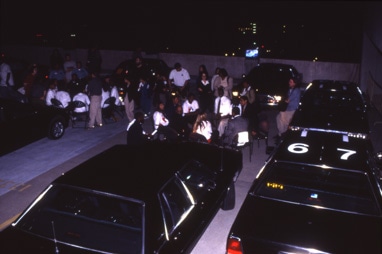Apocalyptic Narratives
Covenantal thinking in early America was accompanied by an apocalyptic narrative. The Hebraic fear of curses for breaking covenant was amplified in the Christian context of the settlements by apocalyptic thinking about sin and judgment, as found in the New Testament. In the apocalyptic narrative that grew up around New Testament texts such as Matthew 24, Mark 13, and the book of Revelation, time is suddenly interrupted by the return of Christ and the judgment of all people, who are divided between eternal reward and eternal punishment (i.e., heaven and hell). Apocalypse becomes the guarantor of covenant, providing the vivid imagery of the everlasting consequences for keeping or breaking covenant. So while entry into the Americas was understood as the reward of paradise, a new world, a new order,1 this promise was not without an accompanying threat of evil that might disrupt this utopic trajectory.
As scholar of American literature Edward Ingebretsen has suggested – and his work is foundational to my argument here – the Puritan settlers’ calling as a divinely favored nation was accompanied by an apocalyptic belief that evil might at any moment creep in, steal all the things held most dear, and destroy the nation.2 Sin was warned against as that which might destroy not only the present communal life, but also the individual’s afterlife. Early Americans were constantly reminded that hell and all forms of evil threatened to intrude at any moment, and of individual susceptibility to entertaining evil. For the Puritans and their successors, Ingebretsen argues, a most terrifying aspect of evil was its ability to creep into the lives of individuals or their neighbors; thus constant guard was kept against it. Interior scrutiny formed good citizens, whose good behavior banished evil and fear. He suggests that many times this scrutiny bled into real life, causing suspicion of anyone or anything different.3 Early preachers like Cotton Mather or Jonathan Edwards were instrumental in shaping consciousness of the invisible world and the ever-present threat of fire and brimstone. This threat of smoldering otherworldly punishment for moral corruption was even dramatized, in the case of the Salem witch hunts, in the burning of heretics.4
Ingebretsen highlights the colonial context in which apocalyptic thought shored up a covenantal “right” to the land. The threat of individual sinfulness to the covenant was amplified by the evil already residing in the land. In Ingebretsen’s words, “the agents of imagined [moral] decline were many – and the Indians, those ‘swarthy demons,’ were always on hand as potential scapegoats to channel this negative energy.”5 Within this context, captivity stories of literal and spiritual bondage flourished, reminding settlers of the aboriginal people who seemed to threaten the nation’s destiny.6 Yet, clearly, the aboriginal peoples were more than just scapegoats. As historian Anders Stephanson shows, early Americans viewed the elimination of aboriginal peoples and the acquisition of new territory as an affirmation of their divine calling to bring civilization and progress to the world. He gives as early examples Winthrop’s assessment of the smallpox epidemic among aboriginal peoples as “miraculous plagey,” and Benjamin Franklin’s assessment of rum as “‘the appointed means’ by which ‘the design of Providence to extirpate these savages’ was fulfilled ‘in order to make room for the cultivators of the earth.'”7 The genocide of aboriginal people was justified through analogy to the biblical promise of Israelite victory over the original Canaanite inhabitants of the promised land who, like the aboriginal people of the Americas, were understood as idolatrous, seductive, and covenant-threatening.8 In a Christian apocalyptic context conquest of the land’s inhabitants was also seen as victory over cosmic forces of evil.
Ingebretsen’s work shows the longstanding connection between expansion of borders by banishing external threats, and the reinforcement of borders, through scrutiny of individual moral shortcomings. Captivity stories, with their thematics of external threat and deliverance, fed more general apocalyptic anxieties about something lurking internally, needing to be caught, uncovered, scrutinized, banished. Ingebretsen goes on to show that apocalyptic fear has remained a politically productive part of the nation’s cultural imagination for centuries. He argues that fear has been both created and managed through religious confessions, devout obsessions with apocalyptic end times and judgments, and in secularized versions through gothic and science-fiction horror stories and films. In his words, “without obvious force or coercive violence, a mythologized religious framework . . . controls without seeming to control; shapes a political order while seemingly indifferent to shape.”9 Ingebretsen’s description of the controlling functions of apocalyptic thought points to the relationship, to which I will return presently, between an externalized fear of the Other and an internalized shame, working together in the imperialist project of expanding borders and maintaining control of those within them.10
- Bercovitch, “The Biblical Basis of the American Myth,” 222-24. [↩]
- Ingebretsen, Maps of Heaven, Maps of Hell. [↩]
- Ingebretsen, Maps of Heaven, Maps of Hell, 21-28; Tina Pippin, Apocalyptic Bodies: The Biblical End of the World in Text and Image (London: Routledge, 1999); Tina Pippin, “Of Gods and Demons: Blood Sacrifice and Eternal Life in Dracula and the Apocalypse of John,” in Screening Scripture: Intertextual Connections Between Scripture and Film, ed. George Aichele and Richard Walsh (Harrisburg, PA: Trinity Press International, 2002), 24-41; Stephen D. O’Leary, Arguing the Apocalypse: A Theory of Millennial Rhetoric (Oxford: Oxford University Press, 1994); and Lee Quinby, Anti-Apocalypse: Exercises in Genealogical Criticism (Minneapolis: University of Minnesota Press, 1994) have also shown how apocalypse forms a deeply seated layer within American culture. [↩]
- Cotton Mather’s tract, Wonders of the Invisible World (1692; Mount Vernon, NY: Peter Pauper, 1950), also details his involvement with the Salem witch hunts. [↩]
- Ingebretsen, Maps of Heaven, Maps of Hell, 21. [↩]
- Ingebretsen, Maps of Heaven, Maps of Hell, 22-27. [↩]
- Stephanson, Manifest Destiny, 11. [↩]
- Robert Allen Warrior, “A Native American Perspective: Canaanites, Cowboys, and Indians,” in Voices from the Margin: Interpreting the Bible in the Third World, ed. R. S. Sugirtharajah, (Maryknoll, NY: Orbis, 1991), 287-95; Laura E. Donaldson, “Postcolonialism and Biblical Reading: An Introduction,” Semeia 75 (1996): 1-14; and Bercovitch, “The Biblical Basis for the American Myth.” [↩]
- Ingebretsen, Maps of Heaven, Maps of Hell, 201. [↩]
- The twinning of external threat and internal shame is something like introjection in Freud’s description of melancholia; it is also something like what Bhabha identifies in colonial and postcolonial contexts as the uncanny (unheimlich), i.e., the repressed fear of the Other, who uncannily reemerges as the stranger within, and who represents a shameful threat to internal order (i.e., homeland security), and must then be exposed. Homi K. Bhabha, The Location of Culture (London: Routledge. 1994), 10, 166-67. [↩]



